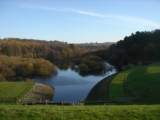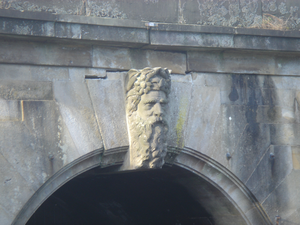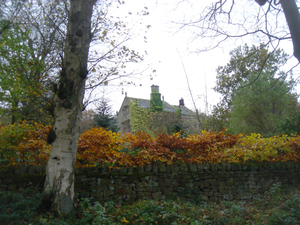
Swinsty Reservoir
Encyclopedia
Swinsty Reservoir is located in the Washburn
valley north of Otley
and west of Harrogate
in Yorkshire
, England
. Construction began in 1871 and was completed in 1878. The capacity is about 866 million gallons, with a surface area of 63 hectares. It can be found from the A59 road
.
The reservoir is below and directly adjoining Fewston Reservoir
.
and the poet Edward Fairfax
. Women in the nearby village of Timble
were twice tried at York
for witchcraft on the accusation of Edward, who suspected them of possessing his two daughters. Neighbouring Fewston Reservoir
covers another Fairfax family home, Cragg Hall.
. Consultants were Thomas Hawksley
of Westminster
and Edward Filliter of Leeds
.
Work on the construction of the reservoir began in 1871. "The Huts", as they were known locally, were constructed to house the workforce, in part using materials from a water mill dismantled in the valley. The bulk of the materials for the dam itself came to Starbeck by rail. From there they were, at first, transported to the site using a steam traction engine pulling wagons. However, by 1872 this practice was put to an end due to the damage being caused to the 'Turnpike road', now the A59
, and from then on materials were transported by contractors.
At the site, a narrow gauge railway was constructed, and two locomotives purchased, the first arriving in 1873 and the second in 1875.
The impact of the construction work was considerable for local residents, in ways both positive and negative. In his diaries, local man John Dickinson mentions the waterworks band coming with their music on Christmas Day, a visit to a "Magic Lantern performance at The Huts" and a waterworks sports day on Swinsty Moor with several hundred in attendance. On the downside, he complains several times of "rough navvies" occupying the local inn at Timble
, and expresses the hope they will soon be gone.
As work neared completion in 1877, the huts were removed and the filling of the reservoir began. Work was finally completed in 1878.
 The reservoir is fed directly from the overflow of neighbouring Fewston Reservoir
The reservoir is fed directly from the overflow of neighbouring Fewston Reservoir
via a shallow spillway which bypasses Fewston Dam and terminates in a grand stepped cascade of falling water. The culvert under the dam itself terminates in an archway topped on the keystone with an ornate carving of the head of Achelous
who stares out over the reservoir itself.
The water is held in place by a small dam on the eastern side, and a much larger one at the southern end, beyond which the River Washburn
continues its descent to join the River Wharfe
.
 On the banks of the reservoir stands Swinsty Hall, built in the 17th century. Local legend has it that the hall was built by a man named Robinson, who left nearby Fewston
On the banks of the reservoir stands Swinsty Hall, built in the 17th century. Local legend has it that the hall was built by a man named Robinson, who left nearby Fewston
to seek his fortune in London
. On arriving there, he found it in the grip of the great plague of 1603-4. Robinson took to looting the houses of the dead and amassed a great fortune with which he returned home, purchased the Swinsty estate, and built Swinsty Hall.
The truth appears more mundane - a family named Wood owned the Swinsty estates in the sixteenth century, and Francis Wood undertook to erect a new hall on the estate as part of a marriage contract. Unable to pay for it, he raised a loan from Henry Robinson, and when he got into further financial difficulties in 1590, Robinson foreclosed and took the hall and estates in lieu of the debt.
The hall was owned by a succession of Robinsons right up until 1772. At this point, the male Robinson line came to an end and the hall and estate passed to Robert Bramley, husband of Mary Robinson, and later his son John Bramley, and in 1853 John Bramley's son, also named John. Stone for the construction of Fewston Reservoir
was purchased from the Swinsty Hall quarry in 1874, from a Mr Bramley.
River Washburn
The River Washburn is a river in Yorkshire, England. It originates high in the Yorkshire Dales and ends where it meets the River Wharfe. It lies within the Nidderdale Area of Outstanding Natural Beauty.-Course:...
valley north of Otley
Otley
-Transport:The main roads through the town are the A660 to the south east, which connects Otley to Bramhope, Adel and Leeds city centre, and the A65 to the west, which goes to Ilkley and Skipton. The A6038 heads to Guiseley, Shipley and Bradford, connecting with the A65...
and west of Harrogate
Harrogate
Harrogate is a spa town in North Yorkshire, England. The town is a tourist destination and its visitor attractions include its spa waters, RHS Harlow Carr gardens, and Betty's Tea Rooms. From the town one can explore the nearby Yorkshire Dales national park. Harrogate originated in the 17th...
in Yorkshire
Yorkshire
Yorkshire is a historic county of northern England and the largest in the United Kingdom. Because of its great size in comparison to other English counties, functions have been increasingly undertaken over time by its subdivisions, which have also been subject to periodic reform...
, England
England
England is a country that is part of the United Kingdom. It shares land borders with Scotland to the north and Wales to the west; the Irish Sea is to the north west, the Celtic Sea to the south west, with the North Sea to the east and the English Channel to the south separating it from continental...
. Construction began in 1871 and was completed in 1878. The capacity is about 866 million gallons, with a surface area of 63 hectares. It can be found from the A59 road
A59 road
The A59 is a major road in the United Kingdom that runs from Liverpool in Merseyside, to York in North Yorkshire.-Merseyside:The A59 begins in the centre of Liverpool at the mouth of the Birkenhead Tunnel, and heads north out of the city, first as Scotland Road in Vauxhall, then Kirkdale Road,...
.
The reservoir is below and directly adjoining Fewston Reservoir
Fewston Reservoir
Fewston Reservoir is located in the Washburn valley north of Otley and west of Harrogate in Yorkshire, England. It was built in 1879. The capacity is about 3.5 million cubic metres. It can be found from the A59 road....
.
Before the reservoir
Beneath the waters of the reservoir are the remains of New Hall, originally a home to the Fairfax family, whose members included Ferdinando FairfaxFerdinando Fairfax
Ferdinando Fairfax was a Virginia landowner and member of the prominent Fairfax family.- Life :...
and the poet Edward Fairfax
Edward Fairfax
Edward Fairfax was a translator, the natural son of Sir Thomas Fairfax the elder, of Denton in Yorkshire, and thus a half-brother of Sir Thomas Fairfax.Fairfax lived at New Hall, Fewston...
. Women in the nearby village of Timble
Timble
Timble is a village in the Harrogate district of North Yorkshire, England. It is situated on the slopes of the Washburn valley, north of Otley and close to Swinsty and Fewston reservoirs....
were twice tried at York
York
York is a walled city, situated at the confluence of the Rivers Ouse and Foss in North Yorkshire, England. The city has a rich heritage and has provided the backdrop to major political events throughout much of its two millennia of existence...
for witchcraft on the accusation of Edward, who suspected them of possessing his two daughters. Neighbouring Fewston Reservoir
Fewston Reservoir
Fewston Reservoir is located in the Washburn valley north of Otley and west of Harrogate in Yorkshire, England. It was built in 1879. The capacity is about 3.5 million cubic metres. It can be found from the A59 road....
covers another Fairfax family home, Cragg Hall.
Construction
The reservoir was built by the Leeds Waterworks Company, and employed a labour force of around 300 men under the management of Robert Brooks, previously an assistant at the construction of Lindley Wood ReservoirLindley Wood Reservoir
Lindley Wood Reservoir is located in the Washburn valley north of Otley in Yorkshire, England. It was built between 1869 and 1876. The capacity is about 750 million gallons.It was the first of a chain of four reservoirs built along the River Washburn...
. Consultants were Thomas Hawksley
Thomas Hawksley
Thomas Hawksley was an English civil engineer of the 19th century, particularly associated with water and gas engineering projects.The son of John Hawksley and Mary Whittle, and born in Arnold, near Nottingham on , Hawksley was largely self-taught from the age of 15 onwards, having at that point...
of Westminster
Westminster
Westminster is an area of central London, within the City of Westminster, England. It lies on the north bank of the River Thames, southwest of the City of London and southwest of Charing Cross...
and Edward Filliter of Leeds
Leeds
Leeds is a city and metropolitan borough in West Yorkshire, England. In 2001 Leeds' main urban subdivision had a population of 443,247, while the entire city has a population of 798,800 , making it the 30th-most populous city in the European Union.Leeds is the cultural, financial and commercial...
.
Work on the construction of the reservoir began in 1871. "The Huts", as they were known locally, were constructed to house the workforce, in part using materials from a water mill dismantled in the valley. The bulk of the materials for the dam itself came to Starbeck by rail. From there they were, at first, transported to the site using a steam traction engine pulling wagons. However, by 1872 this practice was put to an end due to the damage being caused to the 'Turnpike road', now the A59
A59 road
The A59 is a major road in the United Kingdom that runs from Liverpool in Merseyside, to York in North Yorkshire.-Merseyside:The A59 begins in the centre of Liverpool at the mouth of the Birkenhead Tunnel, and heads north out of the city, first as Scotland Road in Vauxhall, then Kirkdale Road,...
, and from then on materials were transported by contractors.
At the site, a narrow gauge railway was constructed, and two locomotives purchased, the first arriving in 1873 and the second in 1875.
The impact of the construction work was considerable for local residents, in ways both positive and negative. In his diaries, local man John Dickinson mentions the waterworks band coming with their music on Christmas Day, a visit to a "Magic Lantern performance at The Huts" and a waterworks sports day on Swinsty Moor with several hundred in attendance. On the downside, he complains several times of "rough navvies" occupying the local inn at Timble
Timble
Timble is a village in the Harrogate district of North Yorkshire, England. It is situated on the slopes of the Washburn valley, north of Otley and close to Swinsty and Fewston reservoirs....
, and expresses the hope they will soon be gone.
As work neared completion in 1877, the huts were removed and the filling of the reservoir began. Work was finally completed in 1878.
Design and architecture

Fewston Reservoir
Fewston Reservoir is located in the Washburn valley north of Otley and west of Harrogate in Yorkshire, England. It was built in 1879. The capacity is about 3.5 million cubic metres. It can be found from the A59 road....
via a shallow spillway which bypasses Fewston Dam and terminates in a grand stepped cascade of falling water. The culvert under the dam itself terminates in an archway topped on the keystone with an ornate carving of the head of Achelous
Achelous
In Greek mythology, Achelous was the patron deity of the "silver-swirling" Achelous River, which is the largest river of Greece, and thus the chief of all river deities, every river having its own river spirit. His name is pre-Greek, its meaning unknown...
who stares out over the reservoir itself.
The water is held in place by a small dam on the eastern side, and a much larger one at the southern end, beyond which the River Washburn
River Washburn
The River Washburn is a river in Yorkshire, England. It originates high in the Yorkshire Dales and ends where it meets the River Wharfe. It lies within the Nidderdale Area of Outstanding Natural Beauty.-Course:...
continues its descent to join the River Wharfe
River Wharfe
The River Wharfe is a river in Yorkshire, England. For much of its length it is the county boundary between West Yorkshire and North Yorkshire. The name Wharfe is Celtic and means "twisting, winding".The valley of the River Wharfe is known as Wharfedale...
.
Swinsty Hall

Fewston
Fewston is a village and civil parish in the Harrogatedistrict of North Yorkshire, England. It is situated north of Otley and close to Swinsty and Fewston reservoirs....
to seek his fortune in London
London
London is the capital city of :England and the :United Kingdom, the largest metropolitan area in the United Kingdom, and the largest urban zone in the European Union by most measures. Located on the River Thames, London has been a major settlement for two millennia, its history going back to its...
. On arriving there, he found it in the grip of the great plague of 1603-4. Robinson took to looting the houses of the dead and amassed a great fortune with which he returned home, purchased the Swinsty estate, and built Swinsty Hall.
The truth appears more mundane - a family named Wood owned the Swinsty estates in the sixteenth century, and Francis Wood undertook to erect a new hall on the estate as part of a marriage contract. Unable to pay for it, he raised a loan from Henry Robinson, and when he got into further financial difficulties in 1590, Robinson foreclosed and took the hall and estates in lieu of the debt.
The hall was owned by a succession of Robinsons right up until 1772. At this point, the male Robinson line came to an end and the hall and estate passed to Robert Bramley, husband of Mary Robinson, and later his son John Bramley, and in 1853 John Bramley's son, also named John. Stone for the construction of Fewston Reservoir
Fewston Reservoir
Fewston Reservoir is located in the Washburn valley north of Otley and west of Harrogate in Yorkshire, England. It was built in 1879. The capacity is about 3.5 million cubic metres. It can be found from the A59 road....
was purchased from the Swinsty Hall quarry in 1874, from a Mr Bramley.
External links
- Yorkshire Water - Swinsty Reservoir
- Old Map - Swinsty Moor, showing New Hall

